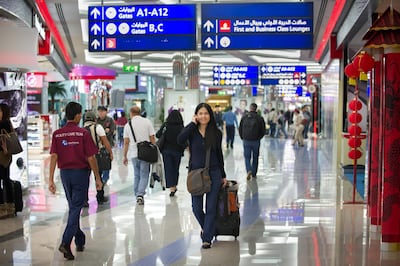Dubai International Airport has soared to great heights since welcoming its first travellers in 1960.
From the sand runway of its humble beginnings to its transformation into a state-of-the-art travel hub, the airport has been on a remarkable journey.
Thursday marked the 60th anniversary of the Dubai International Airport.
DXB has served more than 1.115 billion passengers, travelling on more than 7.47 million flights.
These included connections in more than 240 destinations in 95 countries across the globe.
Sheikh Mohammed bin Rashid, Vice President and Ruler of Dubai, recalled the time when he visited London’s Heathrow Airport at age 10 and when Dubai International overtook it as the world’s busiest airport for international passengers in 2014.
“The first time I arrived at Heathrow Airport in London, I was amazed. At the end of the 1970s, I had a discussion with my father in the evening about a project I had named Destination Dubai,” he said.
“After several years, in 2014, British newspapers published stories with big headlines, 'Dubai Airport bypasses Heathrow as the largest airport in the world' and I remembered my amazement when I was 10 and thought to myself 'Subhan Allah'.”
With 60-years – and counting – of operations, The National looks at some of the airport's key milestones.
Airport’s official opening and early years
Dubai International Airport was opened for civil aviation in July 1937. By February 1938, there were about four Empire Flying Boats operating from the airport per week.
It was in 1959 when Sheikh Rashid bin Saeed Al Maktoum ordered the construction of the airport, with the official opening in 1960. Back then, it comprised of a sand compacted runway and a small terminal building.

It was not until 1963 that work to build an asphalt runway began and then completed two years later. By 1968, Dubai International was served by nine international airlines to 20 destinations.
Several developments took place in the 1970s, including a new three-storey terminal building, control tower, additional taxiways and longer runways.
The second runway, equipped with the latest technology, was opened in 1984.
Dubai Duty Free
Dubai Duty Free began operations in 1983 and had an annual turnover of $20 million in its first year.
In 2019, it became the world’s single largest airport retailer with a turnover of $2.029 billion.
World’s largest airport terminal
Concourse C was opened in 2000 and was part of the general expansion project, worth $545 million. It helped increase passenger capacity from 10 million to 23 million.
By 2003, Dubai International was handling 10 million passengers and was known as Middle East’s aviation hub.
Terminal 3 – the exclusive terminal for Emirates Airline -- was launched in 2008. It is the world’s largest single terminal and grew the airport’s capacity to 60 million.
In 2009, passenger traffic at Dubai airport reached 40.9 million, making it the world’s fastest growing airport and among the top 50 major hubs.
World's busiest airport for international passenger traffic
In 2014, Dubai International welcomed 70.4 million passengers, becoming the world’s busiest airport international passenger traffic.
It overtook London’s Heathrow Airport.
The airport welcomed its one billionth international passenger in 2018.
It retained its title of the world’s busiest airport for international passengers for the sixth consecutive year in 2019, with 86.4 million passengers.
Touchless technology
Dubai airports is also leading the way in implementing the latest technology for passengers departing and arriving.
It was the first to launch e-gates in 2002.
Now, millions of passengers use the smart gates, which requires residents to scan their passport or Emirates ID and helps prevent long queues.
Biometric gates are also in the works at the airport, where arriving passengers would walk through a smart tunnel and go through facial recognition technology.
A pilot phase of the project is ongoing at the airport.
















